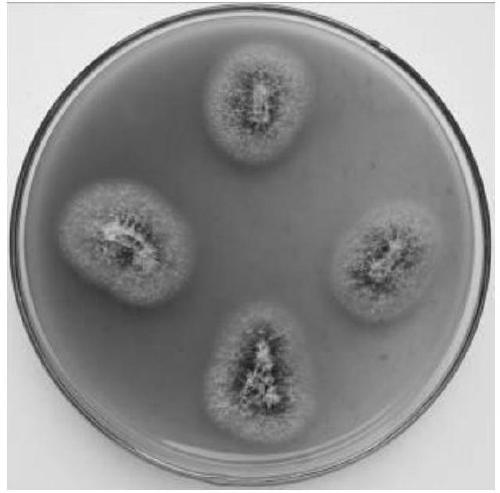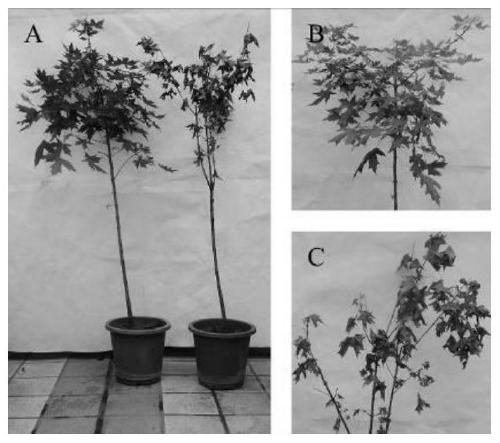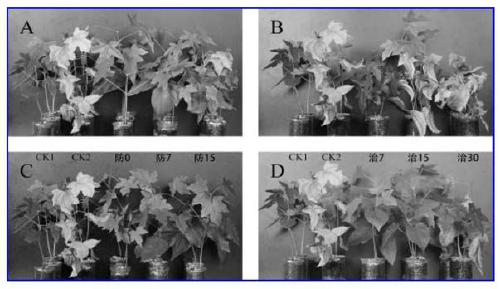A kind of composite antibacterial agent and its application method
A compound antibacterial agent and dosage technology, which is applied in the direction of fungicides, chemical instruments and methods, botany equipment and methods, etc., can solve the problems of rapid spread, rapid loss of agents, and difficult detection of diseases, etc., to achieve enhanced agent Absorb, reduce chemical loss, prevent soil crusting effect
- Summary
- Abstract
- Description
- Claims
- Application Information
AI Technical Summary
Problems solved by technology
Method used
Image
Examples
Embodiment 1
[0049] Pathogen Screening and Identification of Fusarium Wilt of Acer indicum
[0050] The diseased plants were collected and brought back to the laboratory for isolation of pathogenic bacteria. The different parts of the affected plants of Acer indica (root, phloem, xylem, and discolored vascular tissue with typical symptoms) were subjected to tissue separation and dilution coating methods. Bacteria were picked with an inoculation loop to pick a single colony for streaking purification, and fungi were picked with an inoculation loop. Needle-picked mycelia for purification.
[0051] A total of 91 bacterial strains were obtained through tissue separation and dilution coating, including 30 fungal strains and 61 bacterial strains. According to the colony morphology and microscopic observation, 15 strains with the highest frequency were used for subsequent inoculation experiments, and At-13 was isolated from the main xylem of all diseased plants by tissue isolation. The discolor...
Embodiment 2
[0056] Antagonism test of common V.dahliae control agents
[0057] Among them, common V.dahliae control agents are shown in Table 1
[0058] Table 1 Common V.dahliae control agents
[0059]
[0060] The above agents were configured into a poisonous plate with a final concentration of 0.005-1000 μg / mL, inoculated with mycelium blocks of pathogenic bacteria, and coated with about 120 spores / 50 μL of spore liquid. EC of the drug 50 .
[0061] The data analysis results and virulence regression equations of the growth inhibition of pathogenic bacteria by different concentrations of 7 kinds of medicaments are shown in Table 2 and Table 3. The bacteriostatic agents with better antibacterial effects are Shenzimycin and Benomyl. Strong inhibitory ability, EC 50 They were 0.3281 and 0.4966 μg / mL respectively; Ningnanmycin and chlorothalonil had poor inhibitory effects on At-13.
[0062] The inhibitory rate of table 2 fungicides to the growth of At-13 mycelium
[0063]
[006...
Embodiment 3
[0078] A compound antibacterial agent, the composite antibacterial agent includes solid medicament and liquid medicament; wherein the solid medicament contains polyacrylamide of 0.5g / kg, and the rest is nutrient soil; wherein the liquid medicament contains 1% Shenzimycin of 1ml / kg; 1ml / kg of silicone, the rest is sterile water.
[0079] 1% Shenzimycin drug from Shanghai Nongle was used to control 3-year-old maple ingot blight in indoor potted plants, with 10 trees in each group. Among them, the 3-year-old Acer ingot blight disease plants such as Figure 4 shown.
[0080] The branches and leaves of the Acer involucrata diseased plants in the Acer indica blight caused by V.dahliae are re-cut; the consumption of solid medicament is 0.2kg; the consumption of its liquid medicament is 3kg, wherein, the polyacrylamide of 0.1g is mixed with Mix 199.9g of sterilized nutrient soil, and sprinkle it on the roots of potted plants that have already been infected; then take 3ml of 1% Shen...
PUM
 Login to View More
Login to View More Abstract
Description
Claims
Application Information
 Login to View More
Login to View More - R&D
- Intellectual Property
- Life Sciences
- Materials
- Tech Scout
- Unparalleled Data Quality
- Higher Quality Content
- 60% Fewer Hallucinations
Browse by: Latest US Patents, China's latest patents, Technical Efficacy Thesaurus, Application Domain, Technology Topic, Popular Technical Reports.
© 2025 PatSnap. All rights reserved.Legal|Privacy policy|Modern Slavery Act Transparency Statement|Sitemap|About US| Contact US: help@patsnap.com



